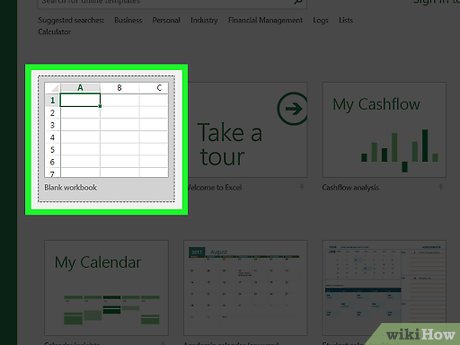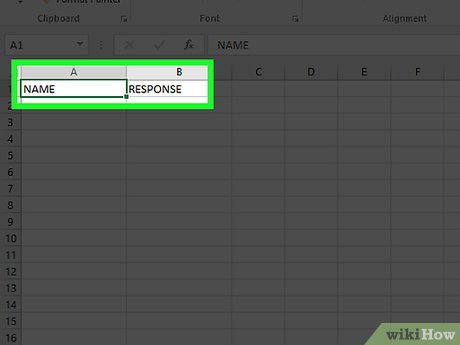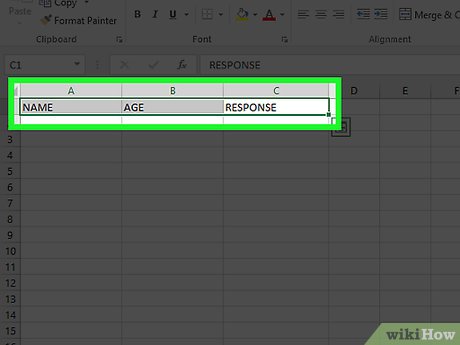How to Create a Random Sample in Excel
Part 1 of 3:
Assembling Your Data in Excel
-
 Open the Microsoft Excel program. You can also open an existing Microsoft Excel document if you have one that correlates to your random sample needs.
Open the Microsoft Excel program. You can also open an existing Microsoft Excel document if you have one that correlates to your random sample needs. -
 Select Blank workbook. If you aren't opening a new document, skip this step.
Select Blank workbook. If you aren't opening a new document, skip this step. -
 Enter your data. To do this, click on a cell into which you wish to input data, then type in your data.
Enter your data. To do this, click on a cell into which you wish to input data, then type in your data.- Depending on the type of data you have, this process will vary. However, you should start all data in the "A" column.
- For example: you might place your users' names in the "A" column and their responses to a survey (e.g., "yes" or "no") in the "B" column.
-
 Make sure you have all relevant data entered into your spreadsheet. Once you're positive that you've added all necessary data, you're ready to generate your random sample.
Make sure you have all relevant data entered into your spreadsheet. Once you're positive that you've added all necessary data, you're ready to generate your random sample.
Part 2 of 3:
Creating a Random Sample
-
 Right-click the far left column's name. For example, if all of your data begins in column "A", you'd right-click the "A" at the top of the page.
Right-click the far left column's name. For example, if all of your data begins in column "A", you'd right-click the "A" at the top of the page. -
 Click Insert. This will add a column to the left of your current left column.
Click Insert. This will add a column to the left of your current left column.- After doing this, any data that was in the "A" column will be relisted as being in the "B" column and so on.
-
 Select the new "A1" cell.
Select the new "A1" cell. -
 Type "= RAND()" into this cell. Exclude the quotation marks. The "RAND" command applies a number between 0 and 1 to your selected cell.
Type "= RAND()" into this cell. Exclude the quotation marks. The "RAND" command applies a number between 0 and 1 to your selected cell.- If Excel attempts to automatically format your "RAND" command, delete the formatting and re-type the command.
-
 Press ↵ Enter. You should see a decimal (e.g., 0.5647) appear in your selected cell.
Press ↵ Enter. You should see a decimal (e.g., 0.5647) appear in your selected cell. -
 Select the cell with the random sample number.
Select the cell with the random sample number. -
 Hold down Control and tap C. Doing this will copy the "RAND" command.
Hold down Control and tap C. Doing this will copy the "RAND" command.- For a Mac, you'll hold down ⌘ Command instead of Control.
- You can also right-click the "RAND" cell and then select Copy.
-
 Select the cell below your random sample number. This will likely be the "A2" cell.
Select the cell below your random sample number. This will likely be the "A2" cell.- Clicking the "A1" cell and highlighting from there can cause a sorting error.
-
 Highlight the rest of the random sample cells. To do this, you'll hold down ⇧ Shift while clicking the cell at the bottom of your data range.
Highlight the rest of the random sample cells. To do this, you'll hold down ⇧ Shift while clicking the cell at the bottom of your data range.- For example, if your data in columns "B" and "C" extends all the way down to cell 100, you would hold down ⇧ Shift and click "A100" to select all "A" cells from A2 to A100.
-
 Hold down Control and tap V. Doing so will paste the random sample command into all selected cells (e.g., A2 through A100). Once this is done, you'll need to sort your data using the random numbers to reorder your results.
Hold down Control and tap V. Doing so will paste the random sample command into all selected cells (e.g., A2 through A100). Once this is done, you'll need to sort your data using the random numbers to reorder your results.- Again, Mac users will need to hold down ⌘ Command instead of Control.
Part 3 of 3:
Sorting Your Sample
-
 Select the top left cell. In most cases, this will be the "A1" cell. Before you can sort your sample, you'll need to highlight all of your data.
Select the top left cell. In most cases, this will be the "A1" cell. Before you can sort your sample, you'll need to highlight all of your data.- This includes the random sample numbers to the left of your data as well.
-
 Hold down ⇧ Shift and select the bottom right cell. Doing so will highlight all of your data, making it ready for sorting.
Hold down ⇧ Shift and select the bottom right cell. Doing so will highlight all of your data, making it ready for sorting.- For example, if your data takes up two columns of 50 cells each, you would select "C50" while holding down ⇧ Shift.
- You can also click and drag your cursor from the top left corner to the bottom right corner of your data (or vice versa) to highlight it.
-
 Right-click your data. This will bring up a context menu with options that will allow you to sort your data.
Right-click your data. This will bring up a context menu with options that will allow you to sort your data.- If you're using a Mac, you can click using two fingers (or hold down Ctrl and click) to bring up the context menu.
-
 Hover your cursor over Sort.
Hover your cursor over Sort. -
 Click Sort Smallest to Largest. You can also click Sort Largest to Smallest here--the only thing that matters is that your data is reorganized randomly according to the "= RAND()" values in the "A" column.
Click Sort Smallest to Largest. You can also click Sort Largest to Smallest here--the only thing that matters is that your data is reorganized randomly according to the "= RAND()" values in the "A" column. -
 Review the sorting results. Depending on how many results you need, your process from here will vary. However, you can do a couple of things with the sorted data:
Review the sorting results. Depending on how many results you need, your process from here will vary. However, you can do a couple of things with the sorted data:- Select the first, last, or middle half of the data. If your number of data points is too large to warrant this, you can also settle on a lower fraction (for example, the first eighth of the data).
- Select all odd- or even-numbered data. For example, in a set of 10 data points, you would either pick numbers 1, 3, 5, 7, and 9, or 2, 4, 6, 8, and 10.
- Select a number of random data points. This method works best for large sets of data where picking half of the information is too ambitious.
-
 Choose your random sample participants. Now you have a non-biased sample pool for a survey, product giveaway, or something similar.
Choose your random sample participants. Now you have a non-biased sample pool for a survey, product giveaway, or something similar.
3.5 ★ | 2 Vote
You should read it
May be interested
- STDEV.S function - The function returns the standard deviation based on a sample in Excel
 stdev.s function: the function returns the standard deviation based on a sample, ignoring logical values and text. standard deviation is a measure of the dispersion of values against the mean. support functions from excel 2010 onwards. syntax: stdev.s (number1, [number2], ...)
stdev.s function: the function returns the standard deviation based on a sample, ignoring logical values and text. standard deviation is a measure of the dispersion of values against the mean. support functions from excel 2010 onwards. syntax: stdev.s (number1, [number2], ...) - 5 websites create the most powerful random password
 today, a strong password is essential on the web. fortunately, you can use the online password generator, which helps create strong and unique passwords for your account.
today, a strong password is essential on the web. fortunately, you can use the online password generator, which helps create strong and unique passwords for your account. - How to create random text in Word
 sometimes, you need a text prepared in a word document for the purpose of presenting or paging the page. read the following article to learn how to do it.
sometimes, you need a text prepared in a word document for the purpose of presenting or paging the page. read the following article to learn how to do it. - VAR.S function - Function that calculates variance based on a sample, ignoring logical values and text in Excel
 var.s function: function that calculates variance based on a sample, ignoring logical values and text. support functions from excel 2010 onwards. syntax: var.s (number1, [number2], ...)
var.s function: function that calculates variance based on a sample, ignoring logical values and text. support functions from excel 2010 onwards. syntax: var.s (number1, [number2], ...) - How to draw charts in Excel
 drawing diagrams on excel are basic and often done, when displaying data based on tables or comparing figures together.
drawing diagrams on excel are basic and often done, when displaying data based on tables or comparing figures together. - How to create a password protection for Excel sheets
 in addition to creating passwords for excel files, we can proceed to set the password for each sheet in excel data to prevent the ability to edit the sheet content, but can still view the content.
in addition to creating passwords for excel files, we can proceed to set the password for each sheet in excel data to prevent the ability to edit the sheet content, but can still view the content. - How to create bullet list in Excel
 creating bullet lists (notation lists) in excel is not as simple as in word because there is no bullet button on the ribbon in excel. therefore, this article will show you 7 ways to create bullet list in excel.
creating bullet lists (notation lists) in excel is not as simple as in word because there is no bullet button on the ribbon in excel. therefore, this article will show you 7 ways to create bullet list in excel. - How to Block Random App Installations on iPhone
 if you are experiencing errors with some applications or games automatically installing on your iphone, follow this article to block random application installation on your iphone.
if you are experiencing errors with some applications or games automatically installing on your iphone, follow this article to block random application installation on your iphone. - Instructions on how to create diagonal lines in Excel box
 manipulating 1 cell into 2 diagonal triangles with a line on excel is a very basic operation and is often performed during the process of creating tables on excel.
manipulating 1 cell into 2 diagonal triangles with a line on excel is a very basic operation and is often performed during the process of creating tables on excel. - How to create Text Box in Excel
 text box on excel is similar to creating on word, helping you create artistic text frames, attracting content viewers.
text box on excel is similar to creating on word, helping you create artistic text frames, attracting content viewers.

























 How to Prevent Excel from Removing Leading & Trailing Zeros
How to Prevent Excel from Removing Leading & Trailing Zeros How to Track your Bills in Microsoft Excel
How to Track your Bills in Microsoft Excel How to Use Macros in Excel
How to Use Macros in Excel How to Download Microsoft Excel
How to Download Microsoft Excel How to Add Autonumber in Excel
How to Add Autonumber in Excel How to Sort Microsoft Excel Columns Alphabetically
How to Sort Microsoft Excel Columns Alphabetically